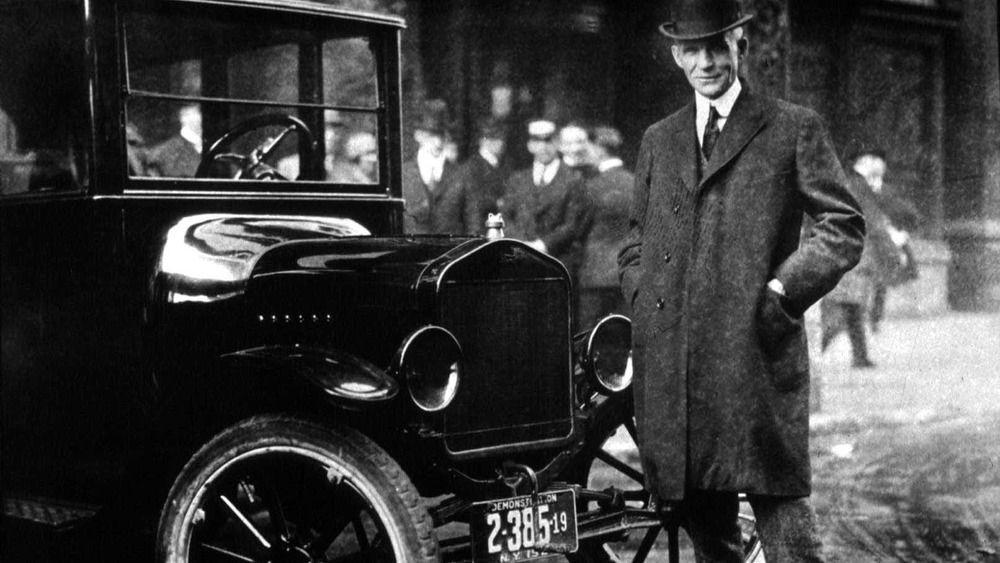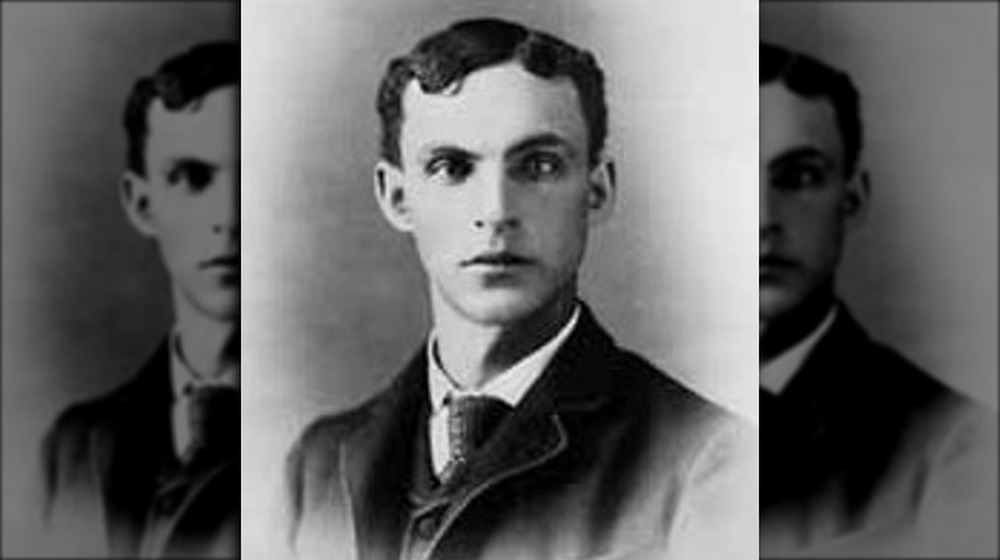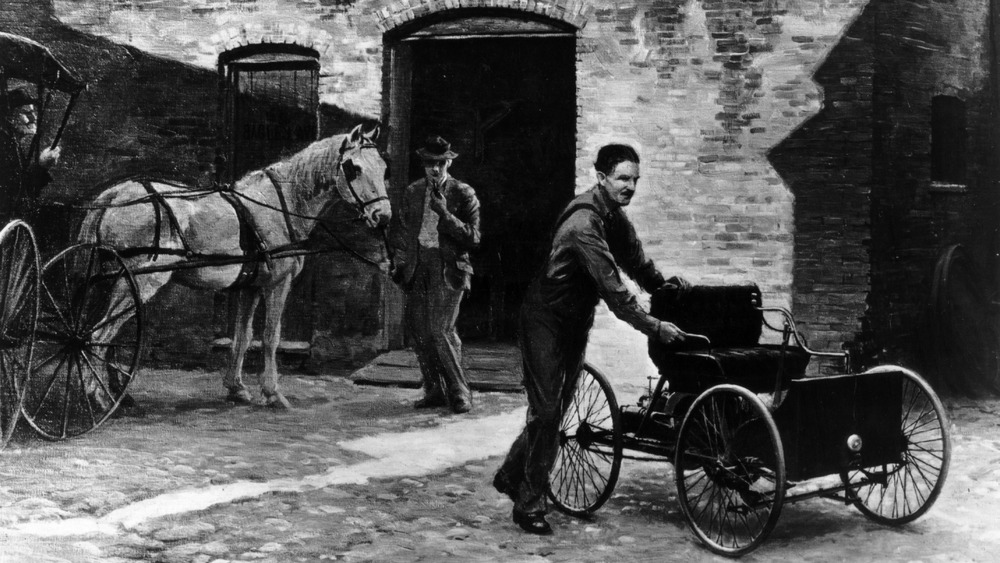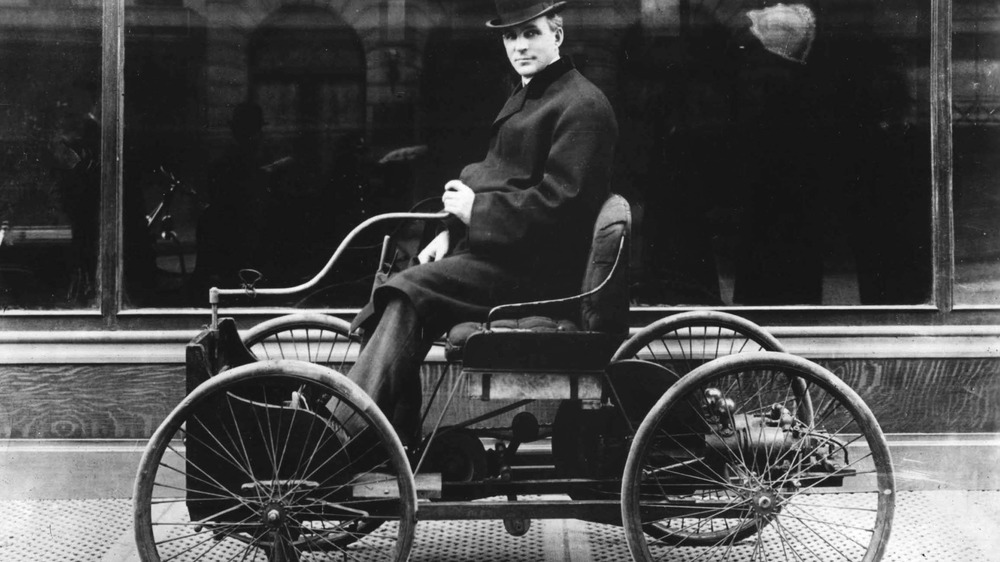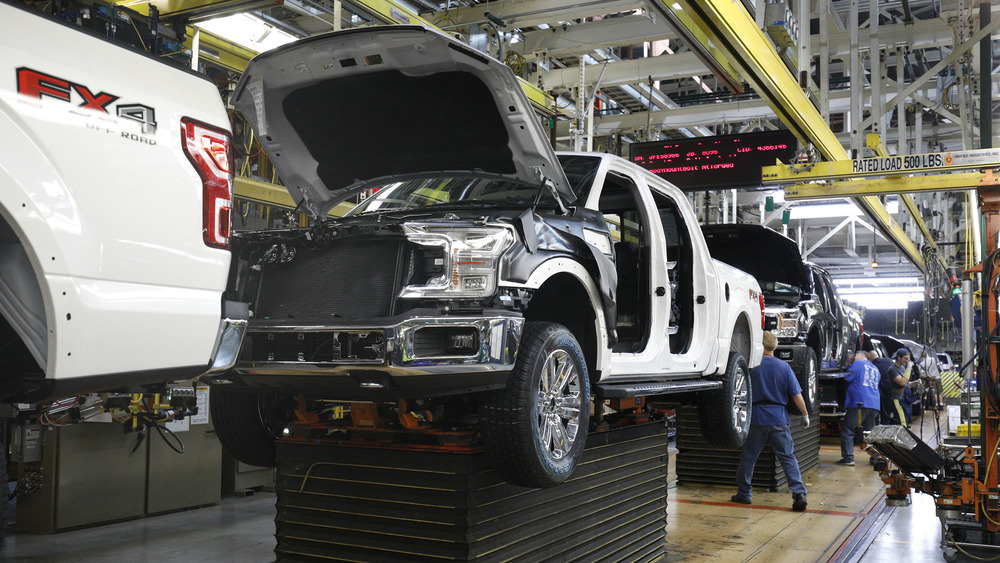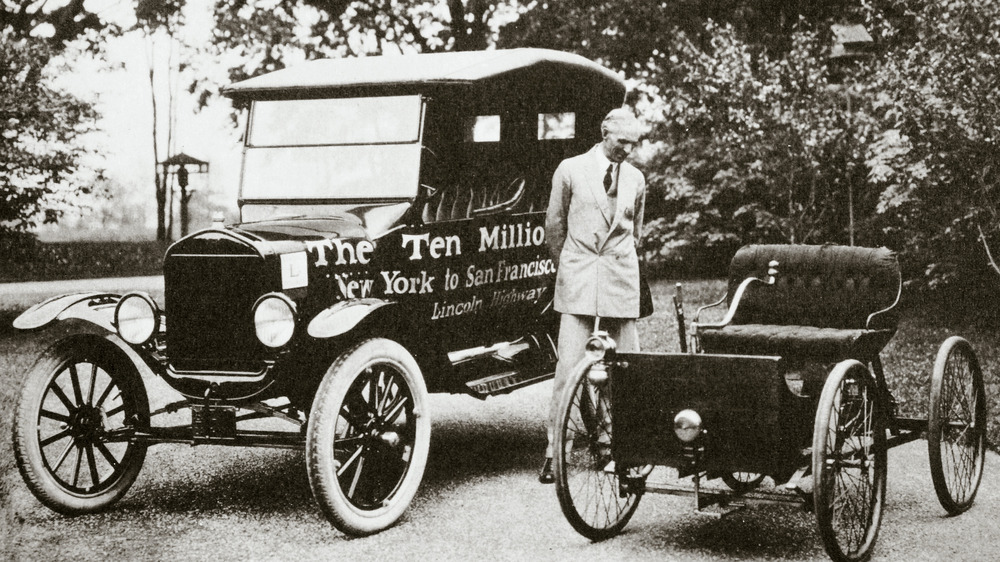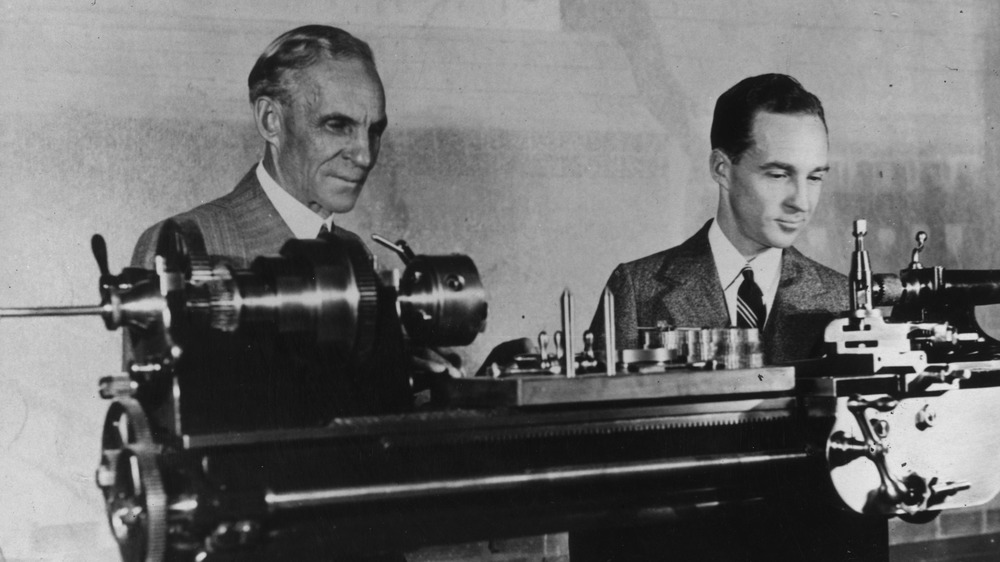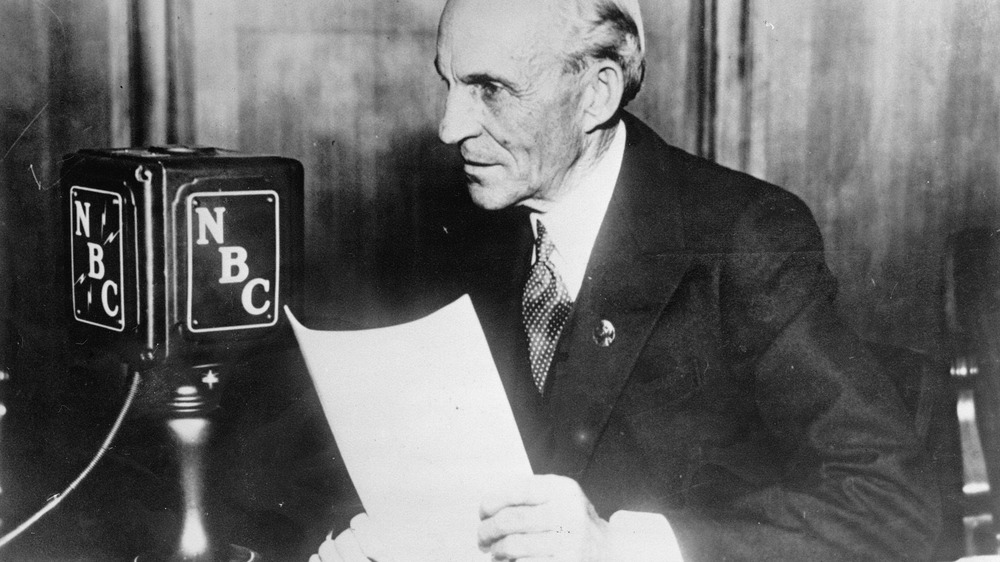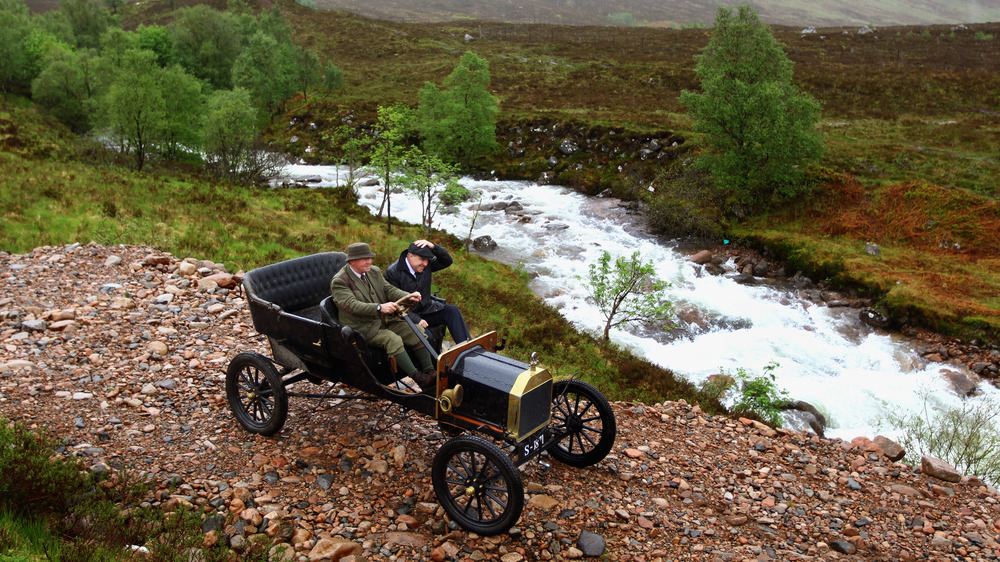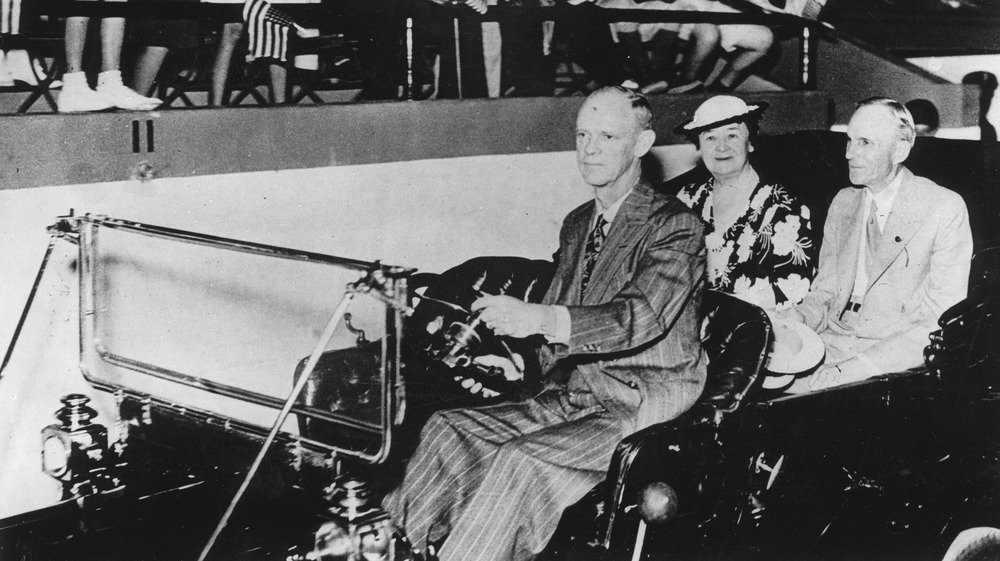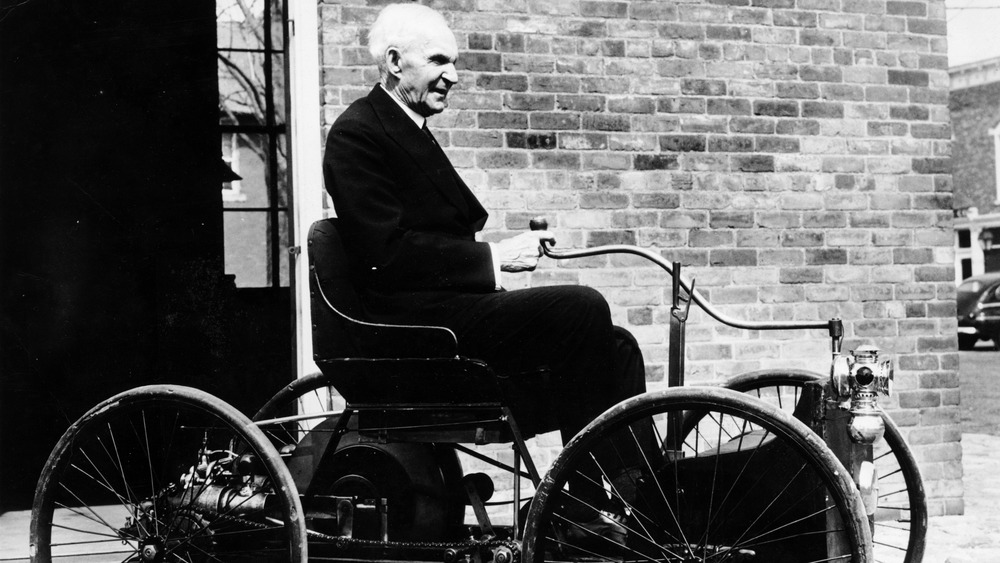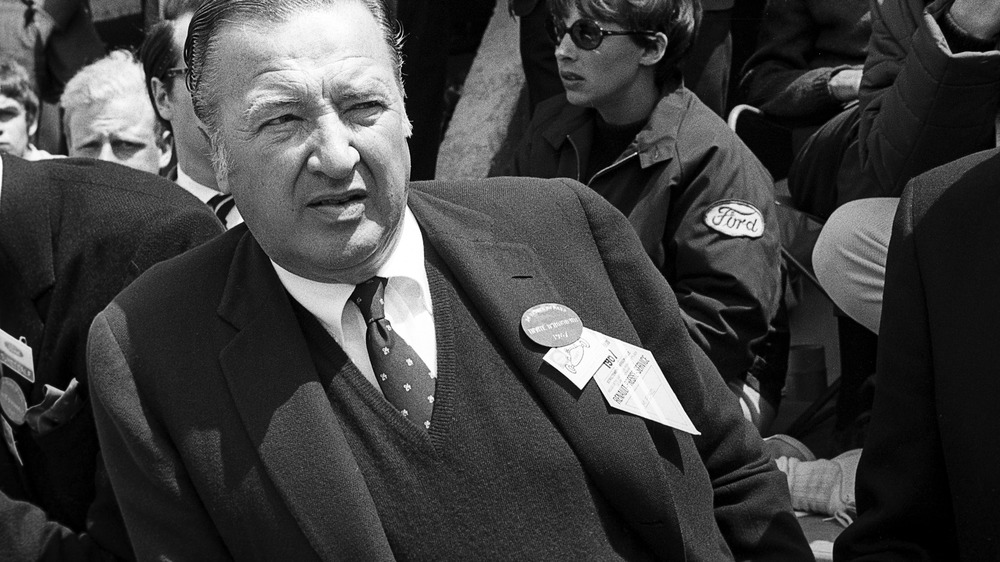How The Ford Family Really Got So Rich
It's safe to say that Americans are obsessed with their cars. It's definitely a case of "go big, or go home," and we love making them bigger, faster, louder, and just, well, more American. It's a love that goes back a long way, and to get technical, the idea of the car goes all the way back to Leonardo da Vinci (via the Library of Congress). The first "modern" cars hit German roads in around 1885, but it wasn't until Henry Ford's Model T started rolling off the assembly line that the American public realized that they not only wanted a car, but that they could have one.
The Ford Motor Company was created in 1903; fast forward 112 years, and the Ford family has done really well. According to Forbes, they were worth around $2 billion, give or take, as of 2015 and the company was still in the hands of various family members. It was the fifth generation of Ford sons, grandsons, and cousins to own the company, and it's the popular tale of the American dream as to how they got so rich in the first place, right? Ford discovered the assembly line, used it to make a ton of cars, sold those cars, and became incredibly rich... right?
Not only is that not entirely accurate, it's definitely not the whole truth — so let's talk about just how Henry Ford made his fortune.
Henry Ford started with nothing
In order to appreciate just how far Henry Ford went, it's worth mentioning where he started. The story of the Ford family's American dream starts in 1847, when Henry's father William left Ireland at a time when famine was widespread... along with starvation and death. According to the Ford Motor Company, William settled in Wayne County, Michigan, married Mary Litogot, and had six children — the eldest was Henry.
The Ford family were farmers, and Autodesk says that by the time he was 16, Henry was working as an apprentice machinist making $2.50 a week (which is about $70 in today's money.) By 1882, he was back on the family farm, but absolutely hated the idea. Instead, he helped make ends meet by cutting wood, upgrading equipment for other farmers, and occasionally picking up some side work in factories.
Henry Ford then spent some time working at the Edison Electric Illuminating Company, but it wasn't long before he had other plans. By the early 1890s, he knew he wanted to go into the car business, but here's the thing: there was no such thing. He later explained, "There was no "demand" for automobiles — They were accepted [as] merely a freak notion and many wise people explained ... why it could never be more than a toy." Years went by, Henry Ford's other business ideas failed miserably, partnerships went bust, and when he quit his job and went into cars full-time in 1899, he was personally penniless.
Make a lot of cheap things, sell 'em
In the early days of the automobile, they were luxury items. They were expensive, impractical toys designed by the rich for the rich and famous, and according to Autodesk, that was the industry that Henry Ford walked into. He had a completely different take on the entire business plan, though, writing: "I will build a motor car for the great multitude. It will be so low in price that no man will be unable to own one."
And that was pretty brilliant. MoneyWeek says that when Karl and Bertha Benz patented their internal combustion engine and started selling cars in 1886, one car cost around $1,000 — adjusted for inflation, that's about $130,000. When Ford (pictured, with an early car) sold his first Model A in 1903, it had a base price of $850 (via Car and Driver), but here's the thing — that kept getting lower and lower. By 1907, the price of a Model N dropped to $600, and fast forward to 1922, and the Model T was being sold for just $269. (Adjusted for inflation, that's about $4,230 today.)
Ford continued to streamline everything about the manufacturing process then passed the savings on to the customer... and profits rolled in. By the time he cut his car's original price by 40 percent, his sales rose 700 times over.
KISS (Keep It Simple, Stupid)
Price and simplicity, Henry Ford found, was key. He wrote (via Entrepreneur): "The less complex an article, the easier it is to make, the cheaper it may be sold and therefore the greater number may be sold." Throughout the run of Ford's most popular car — the Model T — he continued to simplify, going back to the drawing board to get rid of or redesign expensive parts.
Anything he could get rid of, he did, and not only did that make it easier and more cost effective to make, but it also made his cars more accessible. Not only could people now afford to buy his cars, but they weren't afraid to. He wrote: "I thought it was up to me as the designer to make the car so completely simple that no one could fail to understand it."
There was another component to this, too: Ford didn't want to just make his cars affordable to buy, but to own, too. Switching to vanadium steel meant that not only did his costs go down as a manufacturer, but that the cars also got lighter, more efficient, were cheaper to fuel, and that's just one more thing that consumers loved. And consumer love? That translates to dollar signs.
No, Henry Ford didn't invent the assembly line
Things really started to kick into high gear with the Model T. According to History, the Model T went public on October 1, 1908, but it wasn't until 1913 that Henry Ford's Highland Park facility started making them by the score. The plant is still famous as having the first moving assembly line ever created, and that's led to rumors that Ford invented the entire idea. He may have improved on and capitalized on it, but he didn't invent it.
DriveTribe says that the idea of an assembly line — a process where parts are added to a final product as it's passed from worker to worker — goes back to ancient China, where it was used to produce everything from ceramics to weapons. Ford wasn't even the first to use it on a vehicle — that honor goes to the Venetian Arsenal. For almost 700 years, 16,000 workers at a time were employed to staff Italy's massive shipyards, and were able to build an entire ship — from first boards to setting sail — in a single day.
Henry Ford — inspired by the moving lines he'd seen at Chicago meatpacking plants — combined the ideas at his Michigan manufacturing plant. The increase in efficiency was pretty shocking: where they had been taking 12 and a half hours to build a single car before, that was cut to just 93 minutes.
By paying workers really, really well
The development of Ford's moving assembly line allowed him to cut prices and ultimately make — and sell — more cars, but it also came with a major catch. The repetitive work each employee found themselves doing led to an insanely high turnover rate, and Ford found himself running out of employees (via Autodesk.) The solution, he found, was to pay them really well: he offered employees a then unheard-of $5 a day, which NPR says was double what most factory workers could expect to earn at the time.
The pay raise happened just a few months after the installation of the new assembly line, and while it seems like paying employees twice the going rate would do the exact opposite of make an employer money, that's exactly what happened. That extra cash was an incentive for workers to stay on, and it was grueling work: they each had their own specific task that they did over and over and over again, and double pay allowed him to stabilize — and secure — his work force, which meant productivity he could count on.
There was another benefit here, too: it opened up a whole new section of the population that could afford to buy cars now, and it's one of the things credited for kicking off the development of the middle class.
Henry Ford gave workers shorter days
NPR says that in addition to promising his workers $5 a day, Henry Ford also changed what a "day" meant. While it had previously been standard for employees to expect a nine-hour workday, he shorted it to eight. That made his naysayers even more skeptical: paying people more money to work less time? That's insane!
Only, it wasn't. According to Ford Motor Company, gossip on the street at the time was that Ford's ideas were going to leave him bankrupt in short order, but he responded: "We believe in making 25,000 men prosperous and contented rather than follow the plan of making a few slave drivers in our establishment multi-millionaires."
And there were important benefits to that one less hour. Shorter workdays meant increased productivity: one of the complaints workers had was that it was hard to keep up with the pace of the assembly line, and making the day shorter made it not quite as grueling. But it also meant that Ford now had enough time in the day to hire a third shift, which meant that with three shifts working in eight-hour bursts, he could keep his factory going 24 hours a day. Not only did that mean more cars hitting the streets, but they were cheaper to manufacture, too.
Henry Ford broke a potential monopoly
All the time Henry Ford was concentrating on streamlining his manufacturing process and maximizing profits, he was also fighting on another front: vs. the Association of Licensed Automobile Manufacturers (ALAM). The multi-year saga can be condensed like this: according to FEE, ALAM was formed by 11 early car manufacturers who required newcomers to apply to their organization, then pay them royalties on each car sold... if they were accepted as members. Anyone who wasn't accepted was — in theory — forbidden from selling cars, and Henry Ford absolutely wasn't a member.
ALAM was built on an 1895 patent that — they claimed — gave them the rights to the gas-powered vehicle. Ford's rejected application to the ALAM didn't dissuade him, and the entire time he was building the Ford Motor Company, he was being hit by lawsuits and attack advertising. He went to court repeatedly to fight ALAM (alongside other non-ALAM manufacturers), and it dragged on for years. So many years, in fact, that some of Ford's allies — including GM's Billy Durant — gave up the fight. (Durant bailed in 1909, and paid ALAM a whopping $1 million in back royalties. Today, that's the equivalent of around $29 million.)
Ford stuck to his guns, and it paid off. In 1911, the courts ruled that ALAM's patent only applied to vehicles made to the patent's specifications, and Ford — and others — were able to sell cars, royalty-free.
Henry Ford was all about the viral marketing
Advertising was a necessity, but Henry Ford thought that it was a complete waste of money and refused to do it. Ford once wrote (via The Henry Ford Museum of American Innovation): "If you have a really good thing, it will advertise itself."
So wait, what's going on here? In a nutshell, the Ford Motor Company didn't pay to advertise the Model T — they were, after all, selling about as fast as they could make them. There was a reason for that, though: between 1917 and 1923, dealerships spent around $3 million a year (or around $39 million in today's money) advertising Ford's cars for him. Ford simply gave them permission to use the company logo, and passed along some preferred marketing materials which they could choose to use in whatever markets they found most productive.
That's not to say Ford was never a fan of viral marketing, because he definitely was. In 1911, History says that he arranged to make worldwide news with the help of a car dealer in Scotland, who bet his son that he couldn't drive a Model T all the way to the top of the country's tallest peak, Ben Nevis. Henry Alexander, Jr. took the bet (and wagered his allowance), then spent five days driving a Model T up the mountain. (And yes, he drove it back down again.) The car became so popular that Ford figured that was enough marketing for him.
The Model T was almost unthinkably popular
Henry Ford gambled on the fact that an affordable car would be something that the American public would spend money on, and it was a gamble that paid off. Between 1918 and the end of production in 1927, 15 million Model Ts hit American roads and that's not just a high number — ThoughtCo. says that represents about 40 percent of all cars sold in that time.
By the time the Ford Motor Company stopped producing the Model T, they were already a household name. Everyone knew Ford cars and their reputation, and that's a huge deal. Not only were they affordable and reliable, but people knew them as trendsetters. They made left-hand side steering wheels the norm, made things like windshields standard, too, and were easy enough to start and shift that everyone could drive.
The Model T became the symbol of a country chugging along into the 20th century, leaving behind the old, archaic ways of doing things and embracing the modern way of life. No matter what Ford did after that, it was the Ford name that meant progress for millions and millions of Americans — and that's the stuff that fortunes are built upon.
Henry Ford v. the shareholders
Henry Ford was the name of the company, but he wasn't the only one making decisions, much to his chagrin. The world was moving fast, and Ford was moving fast, too: just five years after he announced his $5, eight-hour workday, that became $6... and soon, it became $7. Competitors condemned the move, but so did Ford's shareholders.
According to MBI Concepts Corporation, things really went sideways in 1916. That's when Ford announced he was going to be spending an amount of money most accurately known as "a whole bunch" in expanding their factories at River Rouge and Highland Park, but it was the realization that the project was going to cut into dividends that really had stockholders seething.
So, they took him to court. They claimed his projects — like expansions, worker raises, and contributions to local communities — weren't in the best interest of the company (i.e., their own checkbooks.) The judge ruled that the shareholders were right, and here's where things get weird. The penalty handed down to Ford was that he needed to pay shareholders $19 million (or nearly $460 million today) as a sort of penance. But it was sort of a "joke's on you" scenario. The largest shareholder was Ford himself, so of that $19 million, he got $11 million — or around $266 million today. Then, there was the even more important decision that was made: Ford decided that he wanted his entire company back in his control.
Ford v. Dodge
At the head of the 1916 lawsuit were John and Horace Dodge, two men who not only sued Henry Ford, but added insult to injury by filing the lawsuit the day after they attended the wedding of Ford's son, Edsel. While the Dodges believed they were losing money, Ford believed that not passing on savings to his customers went against everything he'd built the company on.
As the dust from the lawsuit settled, Auto News reported that Ford got to work — and he started by firing upper management who didn't agree with him and getting rid of the board of directors' executive committee. Then, the real brilliance. In 1919, Ford announced he was leaving the Ford Motor Company and concentrating on Henry Ford & Son. The family-owned tractor division, he said, had a new goal: building a car that was even better than the Model T.
The company — and the market — went mad and suddenly, shareholders couldn't get rid of their stock fast enough. Ford and his brokers managed to buy all 8,300 shares of the company that were in hands outside of the Ford family, and dividends were paid out — including $12 million (or $182 million in today's money) to the majority shareholder... i.e., Ford himself. By July 11, 1919, Henry, his wife Clara, and son Edsel Ford owned all of the Ford Motor Company.
The Ford Foundation and an estate loophole
Auto News says that the Ford Motor Company remained a privately-held company for a long time: until January 17, 1956 — nine years after Henry Ford's death — to be exact. That's a lot of time to accumulate a lot of money, and that's exactly what they continued to do... but there was a catch.
In 1935, President Franklin D. Roosevelt was signing all kinds of new things into law, and according to The Motley Fool, that included new inheritance laws. Under new regulations, an estate worth more than $50 million was going to be taxed a whopping 70 percent when it came inheritance time. In response, the Ford family created two different types of stock, and 95 percent of the company was transferred into Class A stock. That was handed over to a new charitable organization called the Ford Foundation, which essentially kept the funds in the Ford family's control, without it being technically a part of the estate.
And as for the Ford family, there are some tragedies there's no planning for. Edsel Ford died of stomach cancer when he was 49-years-old, in 1943 (via the Encyclopedia of Detroit). It was Edsel's son, Henry II (pictured), who stepped in when Henry Ford retired in 1945. He instigated sweeping changes that not only raised sales from an impressive $894 million to a downright shocking $43.5 billion but secured the Ford name — and fortune — well into the future.
